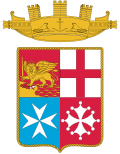 Aldebaran | |
| Class overview | |
|---|---|
| Name | Aldebaran |
| Builders | |
| Operators | |
| Preceded by | N/A |
| Succeeded by | Centauro class |
| Subclasses | Cannon class |
| Built | 1943 |
| In commission | 1951-1976 |
| Planned | 3 |
| Completed | 3 |
| Retired | 3 |
| General characteristics | |
| Type | |
| Displacement |
|
| Length | |
| Beam | 36 ft 10 in (11.23 m) |
| Draft | 11 ft 8 in (3.56 m) |
| Propulsion | 4 × GM Mod. 16-278A diesel engines with electric drive, 6,000 shp (4,474 kW), 2 screws |
| Speed | 21 knots (39 km/h; 24 mph) |
| Range | 10,800 nmi (20,000 km) at 12 kn (22 km/h; 14 mph) |
| Complement | 15 officers and 201 enlisted |
| Armament |
|
The Aldebaran class was a class of three frigates/corvettes/destroyer escorts operated by the Italian Navy. They entered service in 1951, with the last one being decommissioned in 1976. [1]
